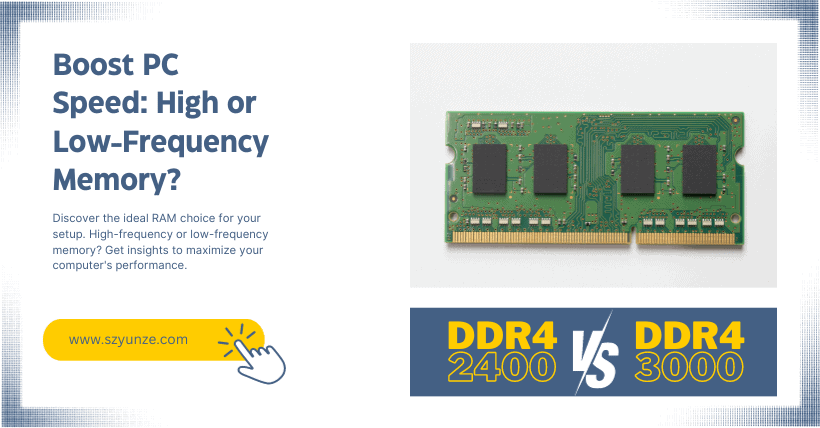When everyone is choosing memory for their computers now, they often consider many aspects, including the brand of memory, how many memory modules to choose, memory capacity, and more. In addition, many people are also somewhat puzzled about the choice between low-frequency and high-frequency memory. There is no doubt that the higher the frequency, the better the performance, and the price naturally becomes higher.
For many users, the purchase of more memory also needs to consider the issue of demand and cost-effectiveness. So, is there a significant difference in performance between high-frequency and low-frequency memory? What frequency of memory is suitable for users? Next, the editor will reveal the answer for everyone.
01
The Test Platform
To shed light on the debate between high-frequency and low-frequency memory, we conducted comprehensive tests on a standardized platform to evaluate their real-world performance. The test setup included the following components:
- Processor: Intel 8th Gen Core i7-8770K
- Motherboard: Z370
- Memory Configuration A: 8GB DDR4 2400MHz
- Memory Configuration B: 8GB DDR4 3000MHz
The memory frequency, timing, and voltage were all set to their default values for an accurate assessment of performance.
02
Performance Benchmarks
① Master Lu Benchmark Test
Our first test, the Master Lu Benchmark, revealed fascinating insights into memory performance. The scores for both memory configurations were as follows:
- DDR4 2400 memory score: 10,476 points
- DDR4 3000 memory score: 10,709 points
Surprisingly, under default settings without enabling XMP (Extreme Memory Profile), the performance gap between DDR4 2400 and 3000 frequencies was less than 250 points. This small performance difference indicated that in some scenarios, the frequency might not be the sole determining factor in memory performance.
② AIDA64 Memory Test
The AIDA64 Memory Test provided a more detailed view of memory performance. The read, write, and copy speeds for both configurations were as follows:
- DDR4 2400MHz memory read, write, and copy speeds: 18,114 MB/s, 16,636 MB/s, and 18,678 MB/s, respectively.
- DDR4 3000MHz memory read, write, and copy speeds: 22,069 MB/s, 19,782 MB/s, and 21,871 MB/s, respectively.
AIDA64 revealed a noticeable speed advantage for DDR4 3000MHz memory, especially in read and write speeds. This indicates that higher-frequency memory can significantly impact specific tasks, particularly those reliant on fast data access.
③ Overwatch Game Test
The Overwatch Game Test allowed us to assess the impact of memory frequency on gaming performance. With all other hardware being identical and only the memory frequency being different, the game frame rates for Overwatch were as follows:
- DDR4 2400 memory score: 135 frames per second
- DDR4 3000 memory score: 132 frames per second
In this test, we observed a minimal impact on game frame rates when using DDR4 2400 and DDR4 3000 memory. This suggests that in certain gaming scenarios, memory frequency may not be the decisive factor in achieving high frame rates.
④ World of Warcraft Game Performance Test
Finally, we examined the performance of an older game, World of Warcraft, which relies on different aspects of hardware for optimal performance. Here are the benchmark results:
- DDR4 2400 memory score: 58 frames per second
- DDR4 3000 memory score: 67 frames per second
In the World of Warcraft test, higher-frequency memory exhibited a more significant impact on game frame rates. This can be attributed to the game’s suboptimal hardware performance optimization, where memory speed plays a more critical role.
03
The Verdict
Higher memory frequencies undeniably offer better performance in terms of read and write speeds, which is an established fact. However, when we consider practical test comparisons, the difference between DDR4 2400 and 3000 memory frequencies may not always be very noticeable, especially in modern systems where other hardware components have advanced significantly.
Memory is no longer the primary bottleneck in computer hardware because it has evolved into a more advanced storage technology than traditional hard drives. With mainstream DDR4 memory offering read and write speeds of over 7000MB/s, it far surpasses the speeds of traditional mechanical hard drives, which top out at around 300MB/s. Even high-performing M.2 NVME solid-state drives can reach speeds of around 3000MB/s.
For the majority of computer users engaged in everyday computing tasks and gaming, DDR4 2400 frequency is more than sufficient to meet their needs. It’s a cost-effective option that balances performance and budget constraints effectively. However, if your budget allows, and you’re striving for top-tier performance and benchmark results, there’s no harm in opting for higher-frequency memory.
It’s important to note that to harness the full potential of high-frequency memory, you may need a high-end CPU and motherboard. In summary, while high-frequency memory undoubtedly offers advantages in specific scenarios, for most users engaging in real-world applications, the difference may not be substantial enough to warrant the investment.
In conclusion, when choosing memory for your computer, consider your specific use cases and budget constraints carefully. While high-frequency memory can provide a performance boost, the practical impact may not always justify the additional cost. Make an informed decision based on your computing needs and financial considerations.




